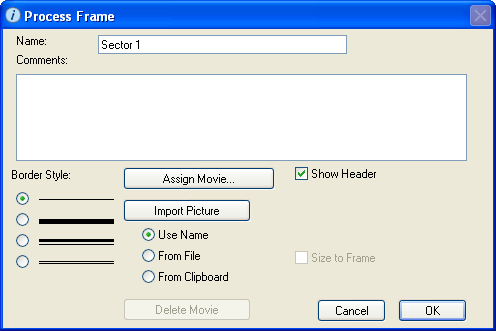
Use the Process Frame dialog box to view and edit the properties of the selected process frame.
To open the Process Frame dialog box, double-click its border or within its header area, or select the process frame and then choose Open Selection from the Interface menu (or right-click the process frame and then choose Open from the menu that appears).

The name of the process frame, which appears in the header of the process frame. This box displays the process frame's existing name. You can change the name here.
If you select the Use Name option, the process frame's name also appears as a picture in the middle of the process frame.
Note: You can also edit the name for a process frame by editing the process frame's name plate in the process frame's header. For more information, see To rename a process frame.
If the process frame is linked to a sector frame, when you change the name of one, the name of the other is automatically changed.
Use this box to record documentation (notes, thoughts, assumptions, etc.) about the process frame.
Select the style of border you want to use for the process frame.
Click this button to have a QuickTime movie clip appear in the process frame.
Notes: If there is already a movie assigned to the process frame, an asterisk (*) appears on the Assign Movie button.
To assign a movie to a process frame, your computer must have QuickTime installed. The Assign Movie button is not available if QuickTime is not installed.
Note: For best results, put all movies in a directory entitled "movies", located in the same directory as the model file.
Click this button to delete the assigned movie from the process frame.
This button appears only if a movie is assigned to the process frame (when a movie is assigned, the Assign Movie button displays an asterisk).
Click this button to select a picture to appear in the process frame.
Note: This button is not available if a movie is currently assigned to the process frame. To assign a picture instead, you must first delete the assigned movie by clicking the Delete Movie button.
To assign a picture to the process frame, select the source of the picture and then click the Import Picture button:
Note: If a picture has already been imported for this process frame, an asterisk (*) appears on the Import Picture button.
For more information about adding pictures to process frames, see To add a picture to a process frame .
Notes: For Macs, you can import PICT files; for Windows machines, see Supported graphic file formats for a list of supported Windows image formats.
For best results, put all picture files in a directory entitled "graphics", located in the same directory as the model file.
Click this button to delete the assigned picture from the process frame.
This button appears only if a picture is assigned to the process frame.
Select this check box to display the process frame's header. If this check box is not selected, the header is hidden.
Note: When you hide the header, its name and navigation button (if the process frame is linked to a sector frame) are also hidden. When the header is hidden, use the options in the Process Frame dialog box to change the name for the process frame.
Select this check box to have the assigned picture or movie resized so that it fits within the borders of the process frame. If this check box is selected and you resize the process frame, the picture or movie will automatically resize accordingly.
Note: When you resize a movie to fit the frame, the subsequent movie playback may be "jagged". QuickTime is optimized to play best when the movie is at its default size.
Tip: You can use the Size to Frame check box to center a movie in the a process frame after you resize the process frame. To do this, select the Size to Frame check box and click OK, then re-open the Process Frame dialog box, clear the Size to Frame check box, and then click OK.
This check box is available only if you have assigned a picture or movie to the process frame.